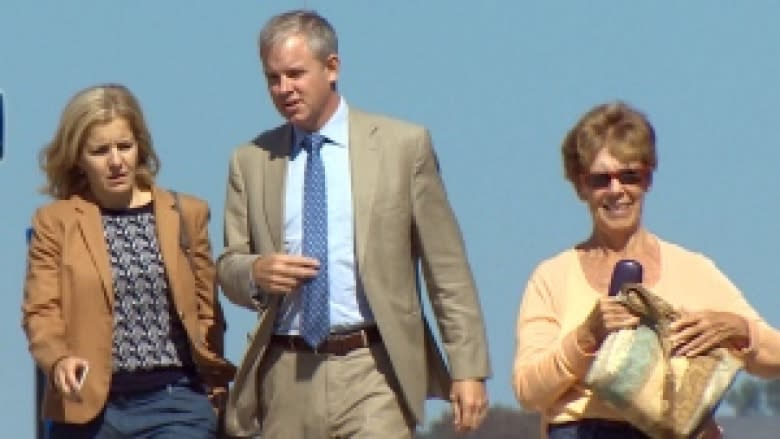Dennis Oland's defence has crucial issues to address at murder trial
Dennis Oland's defence team has several key issues to address in the days ahead at his second-degree murder trial in Saint John, N.B.
Oland, 47, is accused in the bludgeoning death of his father, prominent New Brunswick businessman Richard Oland, whose family operates Moosehead Breweries.
The multimillionaire's body was discovered lying face down in a pool of blood in his investment firm office on July 7, 2011. The 69-year-old had suffered 45 blunt and sharp force injuries to his head, neck and hands.
No weapon was ever found, but police believe it may have been a drywall hammer.
Crown prosecutors wrapped up their case against Dennis Oland earlier this week, portraying him as a man with crippling debts at the time of the slaying and someone who stood to gain financially from his father's death.
Oland, who was the last known person to see his father alive during a meeting at his office the night before his body was found, has pleaded not guilty.
Some of the central issues to the case include:
Victim's DNA on blood-stained jacket
Oland told police he was wearing a navy blazer when he went to visit his father on the night in question, but he was captured on security video and seen by a witness wearing a brown jacket.
The brown Hugo Boss sports jacket was taken to the dry cleaners by Oland's wife, Lisa, on July 8, the day after police told him he was a suspect in his father's death.
The jacket, which was seized from Oland's bedroom closet on July 14, had three small bloodstains on it — on the right sleeve, upper left chest and on the back, near the hem.
DNA extracted from those areas matched that of Richard Oland. The chances of its not being Richard Oland's DNA are one in 20 quintillion, according to a forensic scientist from the RCMP lab.
A bloodstain pattern analyst for the defence contends the killer would have had a "significant amount" of blood spatter on him or her that would be readily visible — not three drops that were all less than two cm in diameter.
The defence has also argued there is no way to know how the blood got on the jacket, how long the stains had been there, or if DNA came from the blood.
Missing iPhone's final ping
Richard Oland's iPhone 4 was the only thing that went missing from the crime scene, while his wallet, Rolex watch, and the keys to BMW that was parked outside were left untouched.
The iPhone was connected to his office computer until 4:44 p.m., on July 6. Dennis Oland arrived at the office around 5:30 p.m. and told police he left around 6:30 p.m.
The last message received by the iPhone was a text message at 6:44 p.m., which was delivered by a cell tower in Rothesay — about a 20-minute drive from Saint John.
The tower is near the Renforth Wharf, where Oland told police he stopped on his way home after visiting his father to see if his children were swimming there.
Two witnesses have described seeing Oland pick up something off the ground at the wharf, sitting down, putting the item into a bag, then leaving.
Earlier in the day, the iPhone had been pinging off a Saint John cell tower near the victim's office. A cellphone expert for the Crown said there was "minimal' chance" the phone was still in Saint John when it connected with a tower in Rothesay.
Richard Oland was was "generally attached to" his cellphone and usually had it in his pants pocket, jacket pocket or on the table beside him, according to his business associate Robert McFadden.
Timeline of events
Dennis Oland told police he left his father's office around 6:30 p.m., although security video shows him walking across the street from the office at 6:12 p.m., and a silver car resembling his driving away at 6:21.
John Ainsworth, who owns the building and the printing business downstairs from Richard Oland's office, testified to hearing "thumping" noises coming from the office between 6 p.m. and 8 p.m.
There was an initial thump, a slight lag, and then eight or 10 thumps, like "rapid fire," said Ainsworth, who now believes the noises were related to Oland's death.
Anthony Shaw, who was with Ainsworth that night, also testified to hearing "a loud crash and then many thumping sounds," coming from Oland's office upstairs, but estimated the time as around 7:30 or 7:45.
The two witnesses who saw Dennis Oland at the wharf said it was "after supper," "between 5:30 p.m. and 7 p.m."
The jury has seen a time-stamped security video of Dennis Oland,wearing different clothes and shopping with his wife at Cochran's Country Market in Rothesay at 7:38 p.m.
A time-stamped security video from the nearby Kennebecasis Drugs store also shows Oland and his wife shopping at 7:38 p.m.
Accused's cash crunch
The Crown has suggested money was a possible motive. The accused was two months behind in making monthly interest-only payments of $1,666.67 on a $500,000 loan he received from his father following a divorce from his first wife.
Oland also had monthly child and spousal support payments of $4,233 to make, plus his living expenses.
The $163,000 limit on his line of credit and $27,000 limit on his credit card were both maxed out, and he had received a $16,000 advance on his salary from CIBC Wood Gundy, where he worked as a financial adviser.
A forensic accountant for the Crown found Oland's spending in the six months before his father's slaying had exceeded his income by nearly $87,000, or about $14,000 a month.
Richard Oland's investments were worth about $36 million when he died.
Dennis Oland received $100,000 for serving as co-executor of his father's will and $50,000 as trustee for a fund set up for his widowed mother, Connie.
Oland also became co-director of his father's three companies and president of the main holding company. No evidence has been presented about how much he is paid for those positions.
Oland's defence has argued his financial problems were not new. He had also bounced an interest payment to his father in July 2010, but the defence contends there was no evidence of any animosity between the father and son over money.
The defence also argues there was no evidence Oland had sought to increase his line of credit and been refused.
Father's extramarital affair
The Crown has also suggested Richard Oland's extramarital affair was a possible motive in his death.
He had been in a romantic relationship with local realtor Diana Sedlacek for about eight years, the trial has heard.
Dennis Oland described the affair as a "family concern" in his statement to police.
He had raised the issue with McFadden, his father's associate, saying "You need to tell Dick that, you know, people know. And that it should stop."
But McFadden testified that conversation was about 18 months before the slaying and the issue was never discussed again.
McFadden said he never broached the subject with Richard Oland. The "opportunity never came up," he said.
Defence lawyer Gary Miller said in his opening statement to the jury, "There is no evidence whatsoever that there was any animosity between Dennis and his father about Diana, Dennis' financial situation or anything else for that matter."
The accused, who told police he had no involvement in his father's death and "no reason" to want him dead, will testify in his own defence, Miller said.
His mother, sister, wife, uncle and a friend will also testify on his behalf.
The trial resumes on Monday at 9:30 a.m. AT, when the defence is scheduled to call a computer expert.
It started on Sept. 16 and is scheduled to run until Dec. 18, making it one of the longest criminal trials in New Brunswick history.





